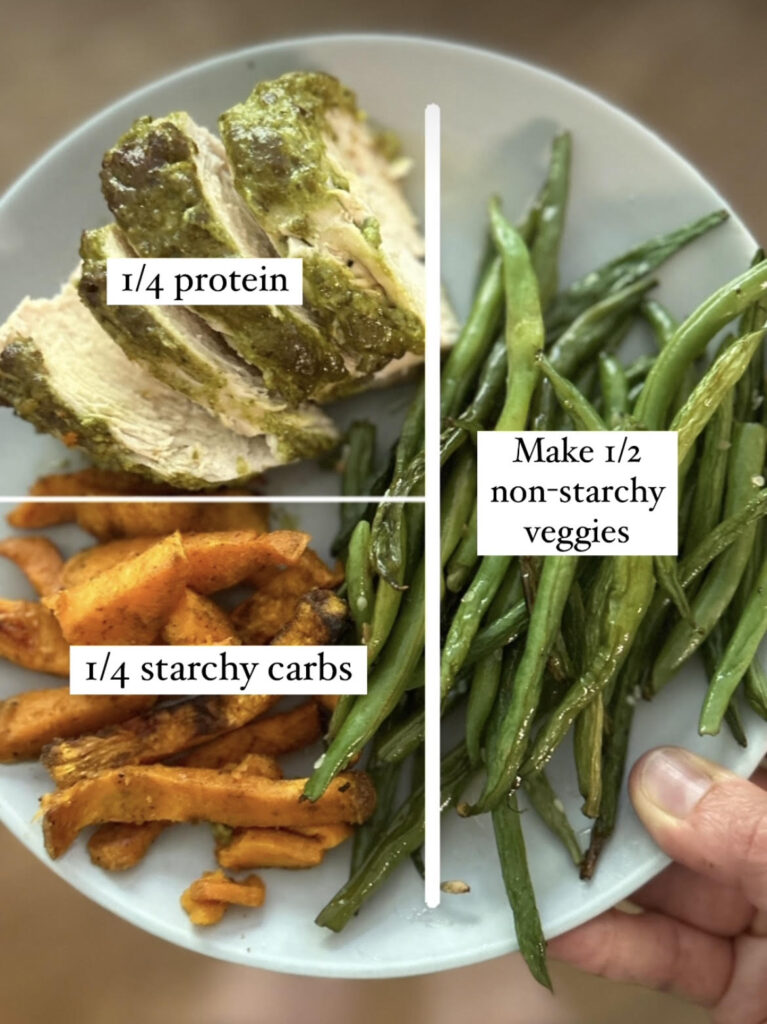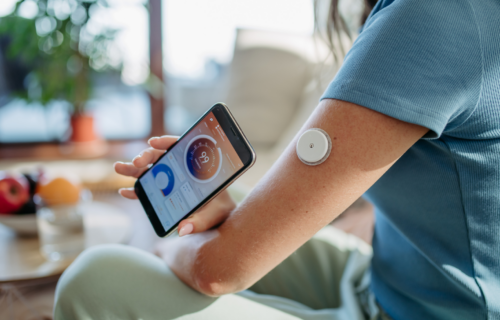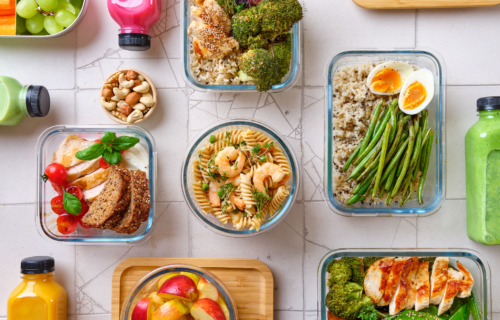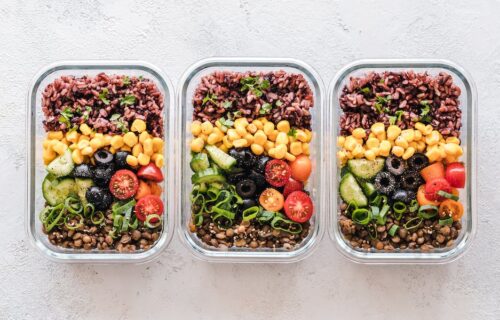
10 Best Weight Loss Tips From a Dietitian (That Doesn’t Involve Dieting)
As a busy mom juggling work, kids, and what feels like never-ending laundry and dishes, finding time for weight loss can feel impossible. The good news is, you don’t need extreme diets or exhausting hours at the gym.
Sustainable weight loss comes down to simple, realistic strategies that fit into your lifestyle. As a registered dietitian for over a decade, I’m sharing my top 10 best weight loss tips to boost your metabolism, lose weight in a healthy way, and feel your best without stress. Not only are these tips backed up by science, I also see these as effective strategies for my clients as well.
Focus on the Progress, Not the Pounds
Rather than getting caught up with the numbers on the scale, focus on small changes that move you toward a healthier lifestyle. Weight loss is a journey, and success comes from consistent effort over time.
Rather than focusing on every pound, celebrate progress like cooking more at home, drinking more water, having more energy, your clothes fitting differently, and having a better sleep schedule.
These non-scale victories add up to long-term success. By shifting your mindset from relying on a number on the scale to tell you how well you’re doing, and instead, focusing on the progress – you’ll naturally see results.
Prioritize Macros Over Calories
While reducing calories is often a focus for weight loss, the quality of your calories is just as, if not more, important. The three macronutrients, protein, fat, and carbohydrates, provide the body with the fuel it needs to function at its best.
Protein is filling, maintains and builds muscle mass, and aids in the production of hormones. Fats like avocado oil, olive oil, nuts, and seeds help you feel fuller longer, are crucial for brain health, and aid in the absorption of vitamins A, D, E, and K. Carbohydrates provide the body with a quick energy source, along with fiber to support healthy digestion.
Prioritizing balanced, nutrient-dense meals instead of calorie restriction ensures you will have the energy needed to keep up with your busy life.
I talk more about balancing your macronutrients to optimize your blood sugar in my book The Blood Sugar Balancing Handbook.
Always Pair a Carb With a Buddy
Carbs often get a bad rap, but they are essential for health and supporting weight loss. The trick is to pair your carbs with a “buddy” like a protein or healthy fat. This combination will slow digestion, stabilize blood sugar, and keep you feeling more full longer (aka less desire to snack later on!)
For example, instead of having an apple on its own, pair it with a hard-boiled egg for a more satisfying and filling snack. Other quick options include berries with Greek yogurt, strawberries with my favorite fruit dip, or crackers with nuts and cheese. These small changes add up, making a big difference when it comes to managing cravings and giving you energy throughout the day.
Use the Plate Method
The plate method is an easy way to ensure your meals are balanced and portioned appropriately without the need to count calories.
Here’s how to structure your plates:
- 1/2 your plate is filled with non-starchy veggies like spinach, broccoli, green beans, and more
- 1/4 of your plate is filled with a protein source like chicken, fish, beef, pork, cottage cheese, or eggs
- 1/2 of your plate is filled with complex carbs like sweet potatoes, quinoa, fruit or rice
- Top it off with a small amount of healthy fats like avocado or avocado oil, or an olive oil dressing

This method ensures you have the right amount of protein, fat, and fibrous carbs on your plate, or what I call PFF (protein, fat, and fiber). When you follow this method, your plate will contain the nourishment you need to fuel your body in a way that will leave you feeling more energized and stay full longer.
Make Your Goals Super Specific
While general goals can help point you in the direction you’d like your health to go, they lack the steps that will help you get there. Instead, focus on setting SMART goals, or goals that are Specific, Measurable, Achievable, Relevant, and Time-Based.
For example, instead of creating general goals of “I want to lose weight,” you could create a SMART goal like “I will eat one cup of vegetables at lunch and dinner 5 days per week” This goal is specific, clear, and can be tracked.
While setting goals, you may find it helpful to break them into smaller chunks so they aren’t as overwhelming and to make sure they are realistic for where you’re at right now. For example, if you currently exercise only when you can find time, setting a goal of exercising for 1 hour every day may be harder to reach compared to starting with a goal of exercising for 30 minutes 2 days per week and slowly working up.
Eat Protein at Every Meal and Snack
Protein is a game-changer when it comes to improving energy levels and promoting weight loss. Protein helps you feel full, reduces cravings, and supports muscle maintenance and growth as you’re working towards weight loss.
Muscle is metabolically active tissue – that means that at rest, muscle uses more energy than other tissues, promoting weight loss. To preserve and build muscle mass while working towards your weight loss goal, aim for 25-30 grams of protein at each meal and at least 10 grams at snacks. This could look like:
- Breakfast: smoothie with protein powder, berries, natural peanut butter and veggies like spinach or diced zucchini
- Lunch: a large salad with chicken and hard-boiled eggs, avocado and an olive-oil based dressing
- Dinner: a power bowl with ground turkey, quinoa, and veggies
- Snack: 1/2 cup of cottage cheese with peaches
Incorporate a 12-hour Overnight Fast
An overnight fast for 12 hours can give your digestive system a break and support metabolism as well as weight loss. The best part? It’s easy to incorporate into your schedule without feeling ravenous waiting for lunchtime.
A 12-hour overnight fast could look like this: If you finish dinner by 7 PM, simply wait to have breakfast until 7 AM.
I like to look at this as an overnight fast rather than intermittent fasting, which often promotes having a short window for eating during the day. Intermittent fasting doesn’t take into consideration that we tolerate carbohydrates better earlier in the day. In addition, over 75% of the studies done on intermittent fasting include men but not women, so the benefits seen may not translate to women well.
This gentle approach can help improve your insulin sensitivity and support healthy weight loss without drastic changes to your routine.
Drink Half Your Weight in Water
“I need to drink more water” is a statement I often hear from my clients. We all know how important water is for our body, but its impact on weight loss is often overlooked. Water supports digestion, detoxifies toxins, and keeps energy levels up. Water also helps ensure our metabolic processes work properly.
Aim to drink half your weight in ounces to ensure you stay hydrated. For example, if you weigh 160 pounds, you should aim for 80 oz of water daily. It’s helpful to carry a water bottle around with you to stay on track – I recommend getting one in your favorite color or with a straw to help you use it more.
If you find plain water boring, try adding lemon, cucumber, or other fruits to add flavor without excessive amounts of added sugar found in other soft drinks.
Focus on Low Glycemic Foods
The glycemic index describes how high your blood sugar will rise after eating a specific food. Foods that have a higher glycemic index will raise your blood sugar quickly, leading to a quick blood sugar crash that will leave you hungry and craving sugar. Choosing low-glycemic index foods can help keep your blood sugar stable, preventing those energy crashes and cravings.
- Examples of low-glycemic foods include: quinoa, beans, nuts, dairy products, non-starchy vegetables like spinach, broccoli, or kale, and fruits like apples, pears, and berries.
- Examples of high-glycemic foods include: white bread, white rice, sugary cereals and baked goods, watermelon, beets, really ripe bananas, and potatoes.
This isn’t to say you can never have a high-glycemic carbs, but focusing on the majority of your carbs coming from low-glycemic carbs can be a great way to support better blood sugar balance.
Watch Your Sugar Consumption
Excess sugar can quickly leave you craving more. The more we consume it, the more we tend to crave it. It’s pretty difficult to avoid sugar completely, and that’s why I recommend aiming for less than 25 grams of added sugar each day. When reading food labels, look at the “Added Sugar” section under Total Carbohydrates to see how much sugar has been added to the product.
Swap sugary snacks and drinks for other healthier alternatives like my Cranberry Mineral Mocktail or my Oatmeal Chocolate Chip Cookies.
Being mindful of added sugar not only helps support weight loss but also better overall health. I have an entire chapter about sugar in my book The Blood Sugar Balancing Handbook available at Amazon, Target, and Barnes & Noble.
Bonus Tip: Have a Plan for Your Meals Each Week
Meal planning and prep are some of the best ways to stay organized, save time, and avoid last-minute choices that often don’t support your health. This doesn’t have to mean spending your entire Sunday in the kitchen cooking, but rather, having a PLAN for your meals during the week can make a big difference.
If you need help finding recipes or creating a meal plan that works for your lifestyle, my FUELED community can help! Inside this monthly membership-based community, you’ll have recipes delivered right to your inbox every Friday. PLUS resources and monthly trainings to help you grow in your health journey.
Learn more about the FUELED Community HERE.
The Bottom Line
Weight loss is more than simply cutting calories and working out more. There’s several pieces of the puzzle to address to support weight loss. So drop the scale, and calorie tracking for practical, sustainable tips that can easily be incorporated into your daily routine. You’ll build healthier habits, boost your metabolism, and reach your weight loss goals without the need to be so restrictive.
Start with small changes, stay consistent, and remember that progress is more important than perfection.




Add A Comment